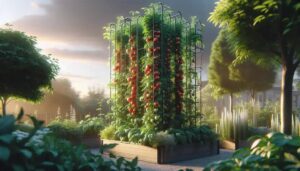Vertical gardens using recycled pallets efficiently transform small spaces by maximizing vertical areas for lush greenery, offering sustenance with herbs and vegetables, enhancing aesthetics, and supporting sustainability through the repurposing of materials, making them ideal for urban living environments.
Ever thought of how recycled pallets can revolutionize your apartment living? These versatile materials can be the foundation for a vertical garden, bringing lush greenery into even the smallest spaces. Imagine transforming a plain wall into a vibrant oasis— intriguing, isn’t it? Let’s dive into the art and practicality of turning recycled pallets into stunning vertical gardens.
Understanding vertical garden system basics
Vertical gardens have become a popular solution for those looking to bring greenery into smaller living spaces, such as apartments. These systems allow plants to grow upwards using a vertical structure, maximizing the use of space while adding a touch of nature to urban environments.
Typically, vertical garden systems consist of a sturdy framework that can hold multiple pots or planters. Some designs use pockets or trays to house soil and plants, while others implement hydroponic systems that deliver nutrients and water directly to the roots. Understanding the basic components and functions of these systems is crucial for anyone looking to create their own vertical garden.
Choosing the Right Structure
The first step in setting up a vertical garden is selecting an appropriate structure. Recycled pallets are an excellent choice due to their affordability and availability. They can be easily customized to fit different spaces and needs, making them perfect for urban gardening projects.
Essential Components for Success
A successful vertical garden relies on several key components: a water delivery system, nutrient-rich soil, and adequate sunlight. Ensure your setup allows for efficient watering, either manually or through a drip irrigation system, and choose plants that suit the light conditions where you plan to install the garden.
By understanding these basics, you’ll be well-equipped to begin your own vertical gardening journey, transforming any urban space into a lush, green oasis.
How recycled pallets transform small spaces
Recycled pallets are a sustainable choice that can transform small spaces into vibrant, lush areas. These reclaimed materials offer an affordable and eco-friendly option to create vertical gardens, making them ideal for urban environments where space is often limited.
By utilizing the vertical space in your apartment or balcony, pallets can hold a variety of plants in a compact, organized manner. This method not only saves ground space but also allows for a creative outlet where nature and design meet.
Benefits of Using Recycled Pallets
The benefits of using pallets include their versatility and ease of customization. They can be painted or stained to match your existing decor, and their simple structure is easy to modify to accommodate pots, planters, or direct planting.
Creating a Vibrant Vertical Oasis
Once installed, these gardens can significantly enhance the aesthetic value of any small space. Imagine a plain wall in your home blossoming into a colorful, textured centerpiece. With thoughtful plant selection, you can achieve various looks, from a tropical paradise to a minimalist herb garden.
Incorporating recycled pallets into your garden design not only creatively uses space but also contributes positively to the environment by repurposing materials.
Step-by-step guide to building your garden
Building a vertical garden using recycled pallets is a rewarding and straightforward project that can enhance your living space. Start by selecting sturdy pallets, ensuring they are free from any harmful chemicals.
Gather Your Materials
You’ll need recycled pallets, landscape fabric, a staple gun, potting soil, and your choice of plants. Make sure to have all tools and materials ready before starting to streamline the process.
Prepare the Pallets
Inspect the pallets for any loose nails or splinters. Sand down rough edges if necessary, and consider giving the wood a coat of sealant or paint to protect it from weather elements if your garden will be outdoors.
Next, staple the landscape fabric to the back, bottom, and sides of the pallet to create a secure pocket for potting soil. Ensure the fabric is tight to prevent soil from spilling out.
Plant Selection and Soil Filling
Choose plants that are well-suited for vertical growth and will receive the necessary sunlight in your chosen location. Popular choices include herbs, succulents, and small flowering plants. Pour potting soil into the pockets, filling each section securely but not overly packed.
Planting and Positioning
Once filled, make small holes in the soil and insert your plants, ensuring each plant is stable. Position the pallet either leaning against a wall or mounted securely, ensuring it receives adequate sunlight and is easy to water.
This step-by-step guide allows you to transform any space promptly, creating a lush and thriving vertical garden with minimal resources.
Choosing the right plants for your space
Selecting the right plants for your vertical garden is crucial for its success and sustainability. Consider the light conditions of your space first. Areas that receive abundant sunlight are ideal for sun-loving plants such as tomatoes and peppers, while shadier spots might suit ferns or herbs like mint and parsley.
Size and Growth Habit
Choose plants that have a size and growth habit compatible with vertical gardening. Compact varieties are ideal as they require less space and support. Trailing plants, like strawberries and certain succulents, can create a cascading effect, adding depth and texture to your garden.
Climate Considerations
Factor in your local climate when selecting plants to ensure they thrive in your environment. Hardy plants are better suited for cooler climates, while tropical plants can be considered for warmer areas.
The right selection of plants can transform your vertical garden into a thriving eco-system, turning even the smallest balcony into a lush paradise. Experiment with combinations that provide not only beauty but also utility, like herbs and edible plants.
Maintenance tips for thriving vertical gardens
Maintaining a thriving vertical garden requires regular care and attention. Consistent watering is essential, as vertical gardens tend to dry out faster due to gravity. Consider installing a drip irrigation system to ensure even moisture distribution across all plant levels.
Fertilization and Nutrition
Provide your plants with the necessary nutrients by applying a balanced fertilizer every few weeks. Organic compost or liquid fertilizers work well for most types of plantings, encouraging healthy growth and vibrant foliage.
Pruning and Pest Control
Regular pruning helps manage plant growth and shape, ensuring each plant receives adequate light and space. Inspect your garden for pests and diseases, using natural remedies like neem oil or insecticidal soap to keep common garden pests at bay.
Maintaining your plants’ health involves monitoring light conditions, adjusting the garden setup if necessary to optimize exposure. Rotate your plants periodically to promote even growth.
With these maintenance strategies in place, your vertical garden will continue to flourish, providing a green sanctuary in your living environment.
Creative inspiration from successful designs
Exploring successful vertical garden designs can spark creative inspiration for your own projects. Consider vibrant gardens that use a mix of flowering plants and cascading vines, providing dynamic color and texture. These designs are not only visually appealing but also functional, incorporating herbs and vegetables for a versatile green space.
Innovative Use of Materials
Some designs creatively repurpose items like old ladders, pipes, and of course, recycled pallets. These elements add character while maximizing space in unique ways. Combining different materials can result in a garden that stands out both aesthetically and sustainably.
Bringing Nature Indoors
Vertical gardens can also be integrated indoors, gracing walls or room dividers. Using plants with varied leaf patterns and colors, such as ferns mixed with succulents, offers an artistic touch while improving air quality.
For outdoor spaces, consider themed gardens—like a Mediterranean herb garden or an exotic tropical wall. Each design provides a distinct look and feel, transforming spaces into personal havens of tranquility and beauty.
Bringing Your Vertical Garden Vision to Life
Creating a vibrant vertical garden using recycled pallets is an exciting way to enhance any apartment space. By understanding the basics, selecting suitable plants, and following maintenance tips, you can transform unused vertical spaces into lush, green oases.
Experiment with different designs and materials, drawing inspiration from successful setups to find the style that suits your environment best. Whether indoors or on a balcony, vertical gardens can improve air quality, provide fresh produce, and create a peaceful sanctuary.
Start small, and build your confidence and creativity, turning your gardening vision into reality. With thoughtful planning and care, your garden will thrive, adding beauty and serenity to your home.
FAQ – Frequently Asked Questions about Vertical Gardens using Recycled Pallets
What are the benefits of using recycled pallets for vertical gardens?
Recycled pallets are cost-effective, eco-friendly, and versatile. They provide a sturdy structure for creating vibrant and space-efficient gardens.
How do I choose the right plants for a vertical garden?
Consider the light conditions of your space. Select plants that thrive in the available sunlight and choose compact or trailing varieties for easy management.
What maintenance is required for a vertical garden?
Regular watering and fertilization are key. Monitor for pests, prune plants to manage growth, and rotate them to ensure even light exposure.
Can vertical gardens be used indoors?
Yes, vertical gardens can thrive indoors. Choose plants that suit indoor light conditions and ensure adequate water and soil nutrition.
What creative designs can I explore with vertical gardens?
You can mix flowering plants and herbs, use different materials like pipes or ladders, and create themed gardens like Mediterranean or tropical walls.
How do recycled pallets contribute to sustainability?
Using recycled pallets reduces waste and promotes the use of sustainable materials in garden design, benefiting both the environment and aesthetics.



